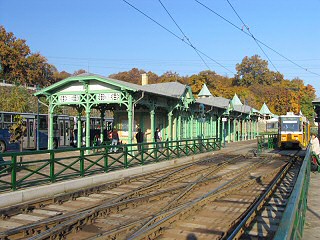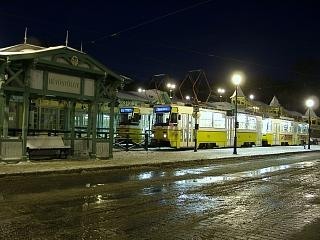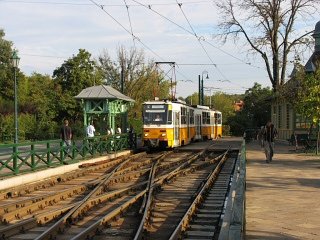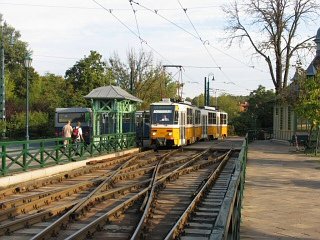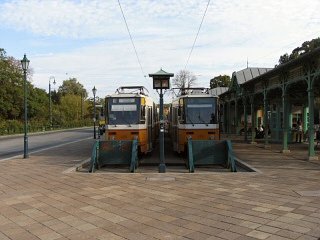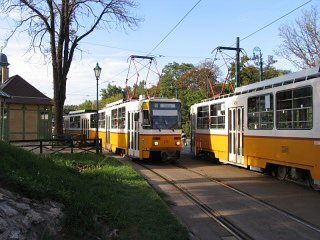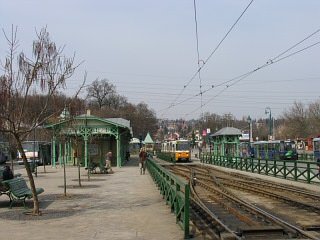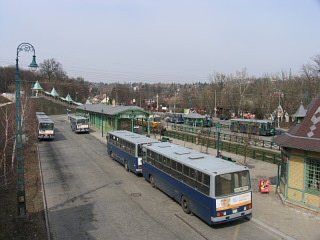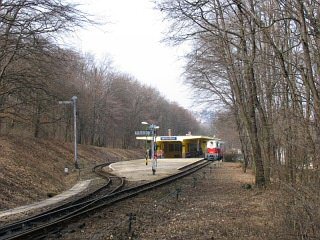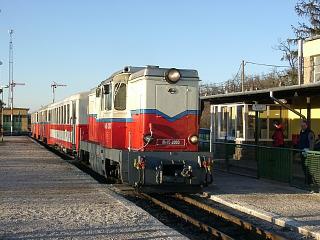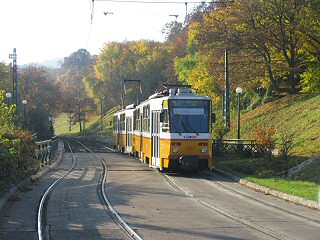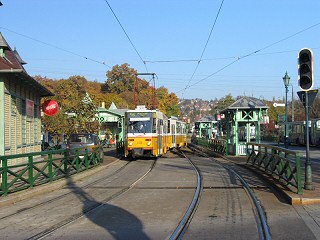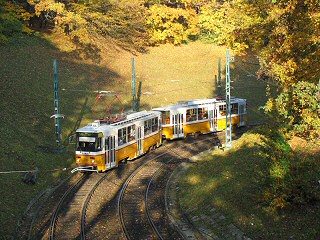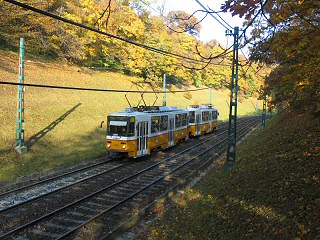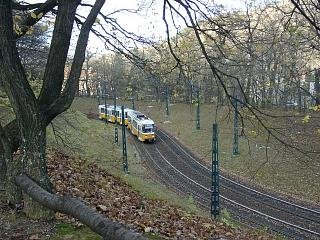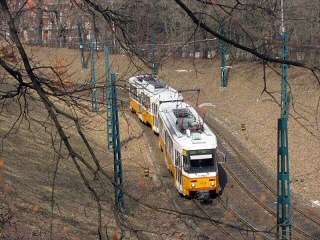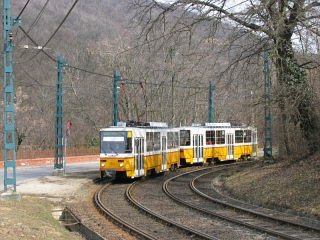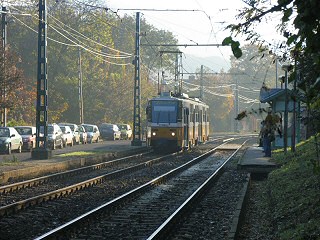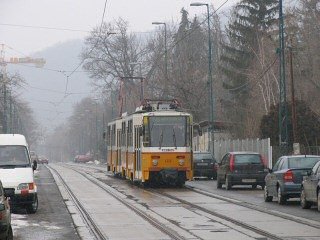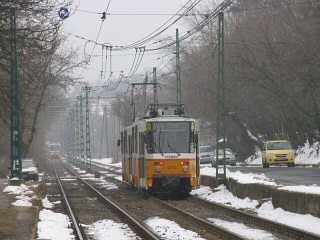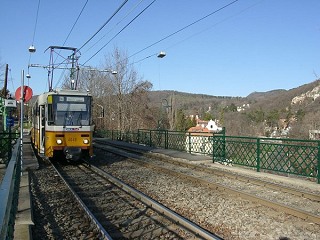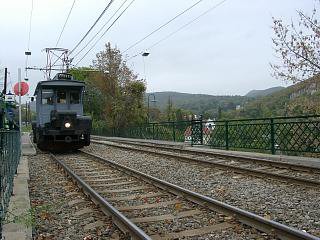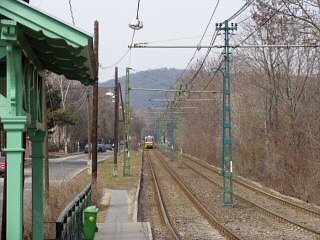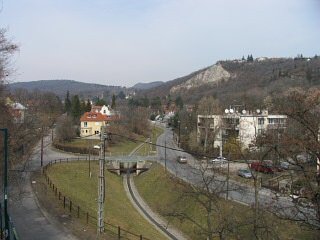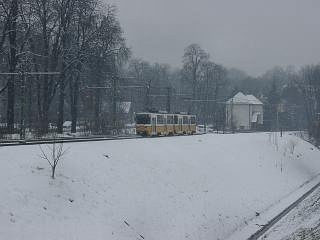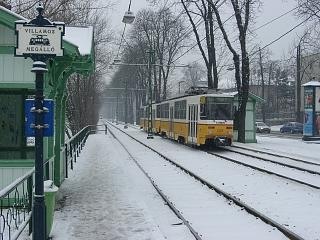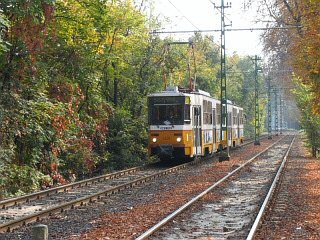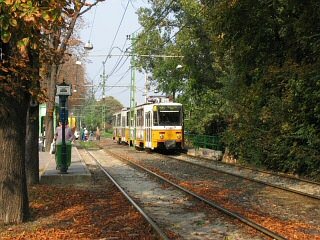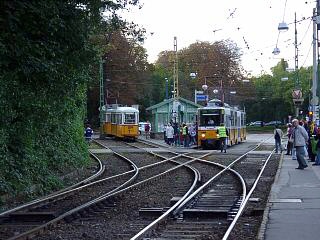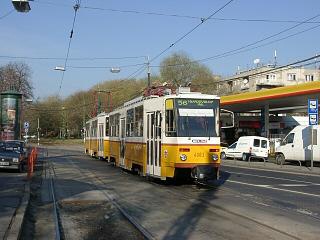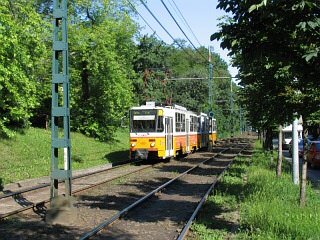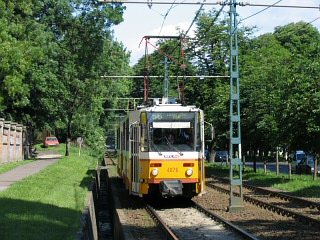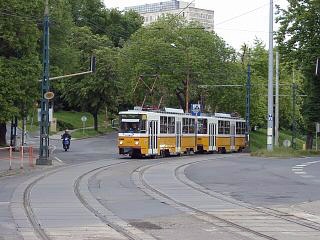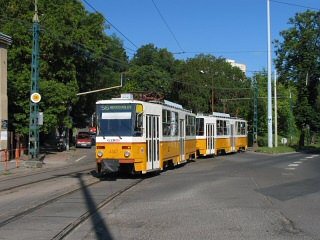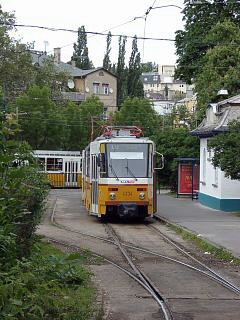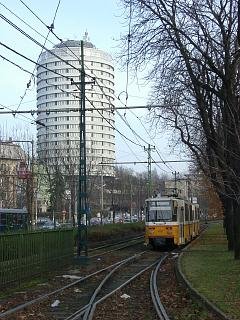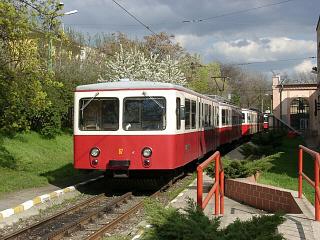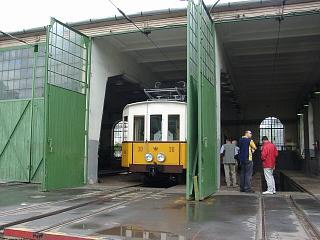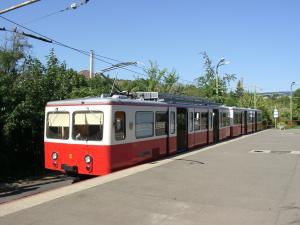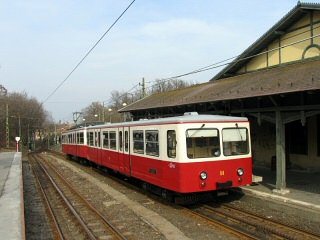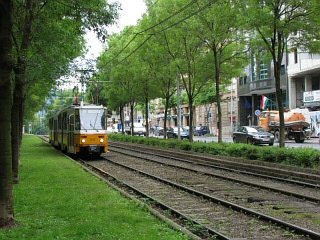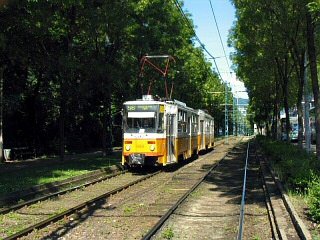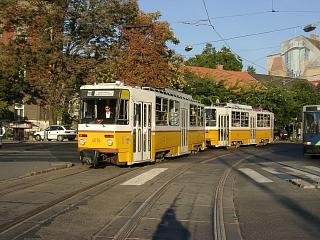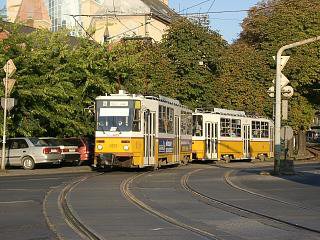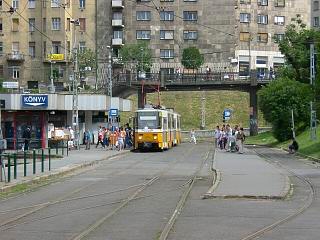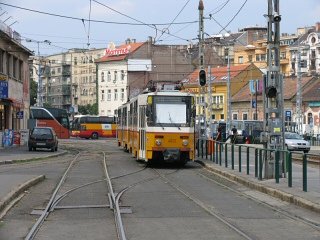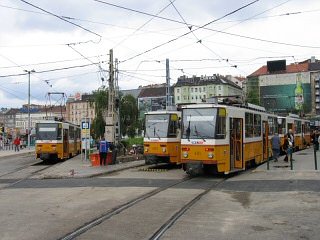Latest update: 21. December, 2007.
The Hűvösvölgy branch: route 56 and 18
Update:On 21. August 2007 route 56 was extended southwards to Budafok, Városház tér over the existing tracks of route 18 and 47, while route 18 was extended northwards to Hűvösvölgy. Therefore it now makes more sense to deal with the branch line leading to Hűvösvölgy rather than with just the routes using it. I will mention route 56 more often, because it's the traditional tram service here, while route 18 is just a temporary thing.
This branch is one of the more prominent ones of the Budapest tram network. It runs in wealthier areas of Buda, and is relatively well maintained - at least in contrast to some other services of Budapest. Some historic features (like the old wooden booths in the stops) and the surroundings make the route a must. As for patronage: on working days its most important job is to carry people from the mountain suburbs into the inner city of Buda, while on weekends it turns into an excursion service: Hűvösvölgy is a popular picnick-place with forests, restaurants and of course the Children's Railway, a.k.a. the Pioneer Railway.
Hint: For railway enthusiasts it's a recommended round-trip to go up to Hűvösvölgy with tram 56, to travel to Széchenyi-hegy from there with the Children's Railway, and then to come back to the city with the Rack Railway.
![]()
Route 56: Hűvösvölgy - Hűvösvölgyi út - Alsó Völgy utca - Versec sor - Hűvösvölgyi út - Szilágyi Erzsébet fasor - Moszkva tér - Krisztina körút - Döbrentei tér - Gellért rakpart - Szent Gellért tér - Bartók Béla út - Móricz Zsigmond körtér - Fehérvári út - Leányka utca - Mária Terézia utca - Budafok, Városház utca (17 km)
Vehicles: 26 x double-sets of T5C5 and T5C5K (from remise Szépilona and Budafok)
Stops
and other information at the villamosok.hu website
Stops
and time-table at the BKV website
Route 18:Hűvösvölgy - Hűvösvölgyi út - Alsó Völgy utca - Versec sor - Hűvösvölgyi út - Szilágyi Erzsébet fasor - Moszkva tér - Krisztina körút - Döbrentei tér - Gellért rakpart - Szent Gellért tér - Bartók Béla út - Móricz Zsigmond körtér - Fehérvári út - Savoya Park (16.2 km)
Vehicles: 17 x double-sets of T5C5 and T5C5K (from remise Szépilona and Budafok)
Stops
and other information at the villamosok.hu website
Stops
and time-table at the BKV website
To give you a hint in what kind of location this route runs in, here's a Google Map. You can clearly make out the terminus near the upper left corner:
![]()
Until the mid-1990s, this route and its terminus was somewhat neglected. But then, as traffic jams got more frequent on the roads due to rising motorisation, they discovered tram line 56 being a direct and relatively unhindered connection into the inner city, so they started upgrading the line. Some stops were consolidated, and a new terminus was built, right next to the buses bringing the people to the tram.
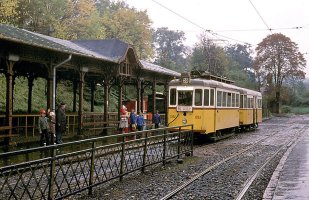
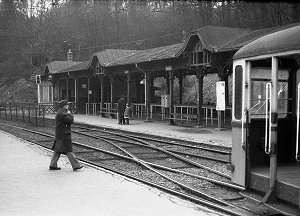
Two photos of the terminus
at its old location (taken by Tim Boric and Mező András)
As an elegant solution, they didn't design a brand new something, but moved (in fact rebuilt) the old terminus buildings a bit further to north instead. They abolished the reversing loop though, but since the Tatras running here were bidirectional, this was no problem.
Despite the loss of the turning circle, this is one of the nicest tram termini I have ever seen anywhere!
The new terminus has two tracks with a scissors crossover.
Since August 21, 2007 the place also acts as as the northern terminus of route 18..
They also built a P+R parking lot above
the pit in which the termini of the buses and trams are located. The terminal
and the depot of the Children's Railway is located above the parking lot,
in only one or two minutes of walking distance.
By the way, you can still recognise the old terminus platforms about 200 meters backwards from the new location.
The upper section: the "canyon"
Trams roll out from the terminus...
... and then you're in paradise :) in the form of a winding cutting.
I like this place in every season: different colors, different lights and shades - it's very atmospheric! You have to walk a bit to get here because it's between two stops, but you can make very nice photos both from the bridge above the trams, and the walls of the "canyon".
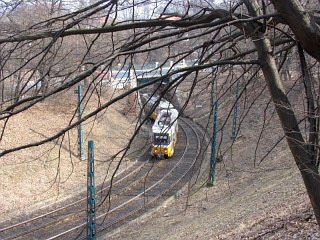
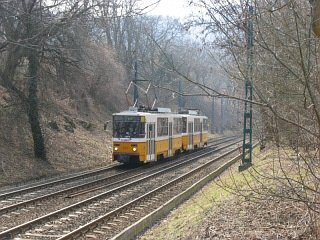
Pale remembrances of a long-lasting
winter
After a few bends, the tracks cross a narrow underpass - so narrow that inbound and outbound trams are not allowed to go through it simultaneously!
The upper section of Völgy utca sports private right-of-way for the trams, but after arriving to a more densly built-in area, the tracks change for a bit of street-running.
Fortunately car traffic is not too heavy here, so trams can move on at a decent speed. And then we're on a separate right-of-way again!
The tram crosses a valley on an embankment here.
It's nice to get off and take a look around at the stop Nagyhíd ("Great Bridge")!
The line still remains "touristic" after arriving to a more urban area, with nice wooden booths for stops, and with the sight of the Ördögárok. The name of this creek translates into "Devil's pit" - justly: although it seems like a harmless brooklet running in an over-dimensioned cut, it has flushed away whole parts of Buda a few times in the past!
Of course the place looks good without snow, too :)
This is where the "lost" (closed) tram route 58 once joined our tracks. Or better, this is where route 56 diverged from route 58, because the latter came first :).
The remaining few hundred meters of route 58 are still in use: this is the connecting section to the Szépilona tram depot.
"Fasor" means alley, and that's exactly how the next few kilometers look like
It's hard to make really nice photos here because of the overhead supports between the tracks!
The environment gets more and more urban as we dive into the city.
Szent János kórház is an old-fashioned hospital where I was born :) And it's also the site of a reversing loop, which is used by route 59 now. Previously it was the terminus of route 18.
A typical photo subject here is the cylindric tower of Hotel Budapest behind the trams.
Our next stop is the lower terminus of
the "Fogaskerekű Vasút", or rack railway (Cogwheel railway).
The depot of the rack railway has a track connection to the tram network, and it's even electrified, so on rare occasions, you can even see trams (special rides, transports) inside there, because the depot is electrified at 600 volts.
The park next to the tracks (not visible on these pictures) is called Városmajor.
We're now reaching the densly urbanised area, which can be seen as the inner city of Buda.
The curve via which the trams approach Moszkva tér is quite photographable in the morning.
Trams 18, 56 and 59 pass through the square on the tracks on the southern side. There's a crossover for reversing while shortenings, and also a reserve track, which we call "The Rusty".
More about
the tram junction Moszkva tér
From here on we share the tracks with route 61 for a while after they leave the stop.
-> Continue to the joint section to Déli pályaudvar
![]()
Back to the
top
Back
to the opening page
Back
to the clickable map
Disclaimer: The author cannot
be held responsible for mistakes, misinterpretations, inaccuracies, inactualities,
etc. on/of these pages, nor for the content of other pages linked in.![]()
Send
a mail to the author
The
author's homepage
